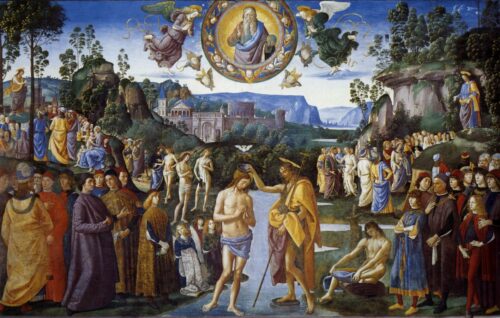
This post comes to us from Kenneth Tanner:
Forget about explanations and analogies for the Trinity (at least for a moment). Better to walk hand-in-hand with Jesus’ disciples down a dusty path to the Jordan. There, among the tall reeds on the bank stands Jesus, who has just walked there from Nazareth, his feet tired, sore, and dirty. Jesus wades in ankle deep. The cool, flowing water is soothing. From here he watches his human brothers and sisters descend one by one, waist-deep, faces drawing near to John the Baptist.
They are entering the water to be cleansed, to repent. Jesus has no need for the cleansing, or the change of heart and mind, and yet here he is, his human face set toward suffering encounter. Bonhoeffer says that Jesus does not assume that he stands apart from the others, does not ponder his perfection, nor feel his superiority, but rather expresses solidarity with everyone gathered to be made well, to amend their ways, by — what wondrous love is this? — presenting himself for baptism, too.
As he approaches John, the Baptist recognizes not only his cousin, with whom he played as a child, but Isaiah’s lamb, the One who takes away the sin of the world. John is reluctant. He does not see why Jesus needs this ritual because he does not see the cross in this watery moment, does not understand that Jesus is already, here In the murky waters of the Jordan, descending into chaos, darkness, and death, taking on himself the sin of the whole world.

For every moment in this story is a story about the cross, and as a story about the cross is also a story about resurrection, but only after it is a story about torture.
This is not a God who remains on the banks of the river, uninvolved and aloof from the pain of existence, but One who joins us in our predicament, participates without sin in the deaths we each of us bear about in our bodies, especially in the moment of our deaths — all the preparatory ones and the last and final one — and is baptized for us and with us.
Unlike the other gods we project and handcraft and make wishes for, this God is a baptized God. He identifies with us so that he might identify us with him.
He also rises out of the waters. He does not stay in the grave. As he comes up out of the chaos and the darkness of the flood, he grasps the wrists of Adam and Eve, rescuing humanity from the fathoms, and he is in prayer. Perhaps he prays, among other things, “Father forgive them.”
Jesus comes up out of the cool, flowing, murky waters, and as he prays — we are told in Matthew, Mark, and Luke — there’s a sound of wings, a flash of feathers, and mystery as the Holy Spirit “alights” on the Son in the body of a dove. Perhaps it rests on his shoulder? Do you see and hear the rustle of divine wings on the air? This is not nearly all. We are told that the sky is torn, a rip in space-time. And through the tear in existence there is suddenly a Voice: “You are my Son, whom I love; with you I am well pleased.”
The majestic voice proceeds from the invisible Father who dwells in light so bright no one can approach him. And yet here this Father is with his Son, who does not wait for us to approach him but who approaches us, who touches his brothers and sisters to heal, who looks upon us with compassion, who embraces us in suffering, who dies with us, that we might ever live.

The Father and the Spirit reveal themselves in this riverside moment where the Son draws near to every human who has ever lived or ever will live, just as the three reveal themselves in the transfiguration and at the cross.
In fact, in Mark’s account of the cross (15:37-39), it’s the same sequence as at the baptism (1:10-11): Jesus breathes his last (expiring the Spirit, which in John’s eyewitness is Pentecostal), then the veil of the temple is torn (the same verb used about the sky in Mk 1:10), and the centurion, who saw how Jesus died, who had seen many men die by crucifixion, somehow saw something more, for he confesses: “Truly this man was the Son of God.”
The baptism of the human God identifies Jesus with sinful humanity, thereby drawing humanity into Love’s triune fellowship. And this why I trust that the Father is pleased with the Son, as he always is.
Baptism and crucifixion go hand-in-hand. Those who are baptized into Jesus’ death also share in his resurrection (Rom 6:3-4). Why on earth would you make an analogy to explain the “mystery of the Trinity” when its truth is revealed in the triune love of God, a story you can enter into and be captivated by? The story of a human God beloved by his father and empowered by the Spirit. A God who loves the world so much that he came not to condemn the world but that the world through him might live.
*thanks to Taylor, Drew, Jason, David, Ryan, Josh, and Todd, with whom I am working my way through Karl Barth’s “Göttingen Dogmatics,” and for prompting this from somewhere deep in the Covid-jaded heart of this mere human that sometimes feels like he has something pressing to say to anyone that might still be listening.

COMMENTS
Leave a Reply












